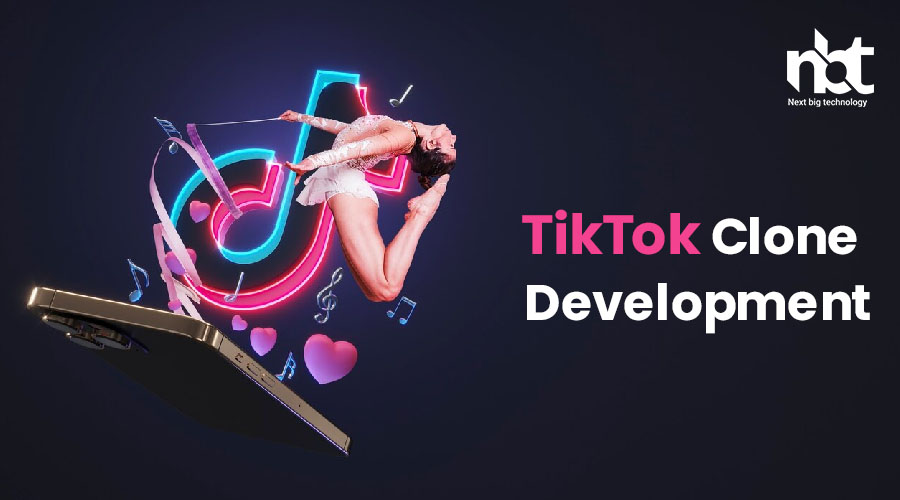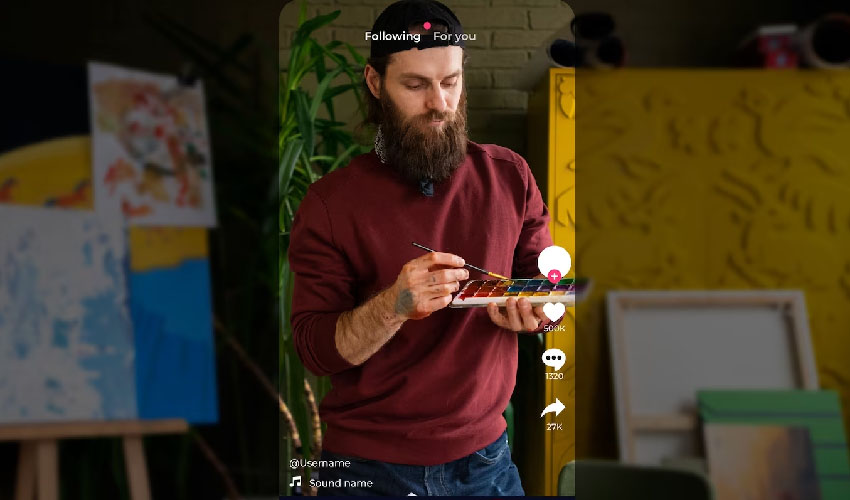Table of Contents
Introduction to TikTok Clone Development
In the ever-evolving landscape of social media, platforms rise and fall, each leaving a unique mark on the digital sphere. Among the most impactful in recent years is TikTok, a platform that has redefined how users engage with short-form video content. As the popularity of TikTok continues to soar, businesses and entrepreneurs are increasingly drawn to the idea of creating their own versions through TikTok clone development.
The Significance of TikTok Clone Development
Riding the Wave of Short-Form Video Content: TikTok’s success lies in its ability to capture the essence of short-form videos, captivating audiences with content that is both entertaining and easily digestible. The surge in popularity of TikTok has underscored the immense potential of short-form video content, making it a prime target for businesses looking to capitalize on current trends.
TikTok clone development is not merely an attempt to replicate the success of the original app but an opportunity to customize the experience for a specific audience or niche. By developing a TikTok clone, businesses can leverage the proven success of the short-form video format while tailoring it to meet their unique objectives.
Tapping into Target Audiences: One of the key advantages of TikTok clone development is the ability to tap into specific target audiences. Understanding the demographics, interests, and preferences of the intended user base is crucial for creating a clone that resonates with its audience. Whether targeting a niche market or catering to a broader demographic, TikTok clone development allows for customization to align with the vision of the business.
Key Features of TikTok Clone Development
User-Friendly Interface: Navigating the Experience: A TikTok clone’s success hinges on its ability to offer users an intuitive and seamless experience. The familiar swipe and scroll features, coupled with a visually appealing interface, contribute to the overall user engagement. The user-friendly design should prioritize ease of navigation, ensuring that users can effortlessly explore and interact with the app.
Video Creation and Editing Tools: Fostering Creativity: At the heart of TikTok clone development lies the video creation and editing tools. These tools empower users to unleash their creativity, offering features such as filters, effects, and music integration. Mimicking TikTok’s success in providing a platform for users to express themselves through unique and entertaining content is essential for the clone’s success.
Social Sharing and Interaction: Building Communities
Social sharing is a fundamental aspect of TikTok’s success. A TikTok clone should facilitate easy sharing of videos across various platforms, amplifying the reach of user-generated content. Additionally, interactive features such as comments, likes, and duets foster a sense of community, encouraging users to engage with each other’s content.
Algorithmic Content Recommendation: Personalizing the Experience
Central to TikTok’s addictive nature is its algorithmic content recommendation system. TikTok clone development should prioritize the implementation of a robust recommendation system that analyzes user behavior and preferences. This ensures that users are consistently exposed to content tailored to their interests, enhancing the overall user experience.
Monetization Opportunities: Balancing Revenue and User Experience
While TikTok clone development aims to provide an engaging user experience, it is equally important to consider monetization opportunities. In-app advertisements, partnerships with influencers, and premium subscription services are avenues to explore for generating revenue. Striking a balance between revenue generation and user satisfaction is crucial for the long-term success of the TikTok clone.
Key Features of a Successful TikTok Clone
In the ever-evolving realm of social media, TikTok has risen to prominence as a global juggernaut, captivating audiences with its innovative short-form video content. Entrepreneurs and businesses seeking to capitalize on this trend are increasingly turning to TikTok clone development. In this comprehensive exploration, we delve into the intricacies of creating a successful TikTok clone app, emphasizing key features that can set it apart and contribute to its overall success.
1. Advanced Video Editing Capabilities: One of the fundamental attractions of TikTok lies in its sophisticated yet user-friendly video editing tools. A successful TikTok clone must offer a diverse range of editing options, including filters, effects, transitions, and augmented reality (AR) features. Providing users with the ability to enhance and personalize their videos fosters creativity and ensures a dynamic and engaging content ecosystem.
2. Innovative Augmented Reality (AR) Integration: Augmented reality has become a game-changer in the world of social media. Integrating AR features into a TikTok clone allows users to overlay digital elements onto their videos, unlocking a new dimension of creativity. This could include face filters, background effects, and interactive elements, providing users with a unique and immersive video creation experience.
3. Multi-Platform Compatibility: To maximize reach and accessibility, a successful TikTok clone should be compatible with multiple platforms. Cross-platform functionality ensures that users can seamlessly transition between devices, from smartphones and tablets to desktop computers. This flexibility not only enhances user experience but also broadens the app’s user base.
4. Robust Content Moderation System: Maintaining a safe and positive environment is paramount for the success of any social media platform. Implementing a robust content moderation system is crucial to filter out inappropriate or offensive content. Utilize a combination of AI-driven algorithms and human moderation to ensure that user-generated content aligns with community guidelines and legal standards.
5. Real-time Analytics and Insights: Empower content creators and administrators with real-time analytics and insights. This feature provides valuable data on user engagement, video performance, and audience demographics. By understanding user behavior, the TikTok clone can optimize its algorithms, enhance user experience, and offer personalized content recommendations.
6. Seamless Integration with Music Libraries: Music is at the core of the TikTok experience. A successful TikTok clone should establish partnerships with major music labels and provide users with an extensive library of licensed songs. Additionally, consider integrating user-generated sounds and music, allowing creators to contribute to the platform’s audio ecosystem.
7. Personalized User Feeds and Recommendations: Tailoring the user experience based on individual preferences is a key aspect of TikTok’s success. Implement a sophisticated recommendation algorithm that analyzes user behaviour, engagement patterns, and content preferences. By offering personalized feeds and recommendations, the TikTok clone enhances user satisfaction and retention.
8. Collaborative Features: Foster a sense of community by incorporating collaborative features such as duets, reactions, and challenges. These features enable users to interact with each other’s content, fostering a sense of camaraderie and creativity. Collaborative features also contribute to the viral nature of content on the platform.
9. Secure User Authentication and Data Privacy: Prioritize user security by implementing robust authentication mechanisms and adhering to strict data privacy standards. Communicate the app’s privacy policy to users and provide them with control over their data. Building trust through transparent privacy practices is essential for long-term success.
10. Monetization Opportunities for Creators: To attract and retain content creators, a TikTok clone should offer diverse monetization avenues. This could include ad revenue sharing, brand partnerships, virtual gifts, and a creator fund. Empowering creators to monetize their content encourages a vibrant ecosystem of high-quality content and incentivizes user engagement.
11. Interactive and Gamified Elements: Introduce gamified elements to enhance user engagement. Features like challenges, badges, and virtual rewards add a competitive and entertaining dimension to the platform. Gamification not only retains users but also encourages them to create and share more content.
12. Adaptive Streaming Technology: Invest in adaptive streaming technology to ensure smooth video playback across various network conditions. This technology adjusts the video quality in real time based on the user’s internet connection, providing a seamless viewing experience and reducing buffering issues.
13. Cross-Platform Social Sharing: Facilitate seamless social sharing by integrating with other popular social media platforms. This extends the reach of the TikTok clone, allowing users to share their content on platforms like Instagram, Twitter, and Facebook. Cross-platform sharing enhances discoverability and contributes to the app’s virality.
14. Continuous Innovation and Updates: Stay ahead of the curve by prioritizing continuous innovation and regular updates. Monitor industry trends, user feedback, and technological advancements to introduce new features and improvements. This commitment to innovation ensures the TikTok clone remains relevant and competitive in the dynamic social media landscape.
15. Scalability and Infrastructure: Plan for scalability from the outset to accommodate the potential growth of the user base. Invest in a robust infrastructure that can handle increased user traffic and data storage requirements. Scalability is essential for providing a consistently reliable and responsive user experience.
User Experience (UX) Considerations in TikTok Clone Development
User Experience (UX) plays a pivotal role in the success of any app, and TikTok clone development is no exception. Crafting a seamless and engaging user journey is essential for attracting and retaining users in the highly competitive world of short-form video content. In this in-depth exploration, we’ll delve into the crucial UX considerations that developers should prioritize to ensure the success of their TikTok clone.
1. Intuitive User Onboarding: The first interaction users have with your TikTok clone is the onboarding process. Aim for a smooth and intuitive experience that allows users to quickly understand how to navigate the app. Implement a straightforward registration process, possibly integrating social media logins to reduce friction. Guide users through the essential features, ensuring they feel comfortable and confident in using the app from the very beginning.
2. User-Friendly Navigation: Efficient and user-friendly navigation is a cornerstone of a positive UX. In a TikTok clone, users should be able to effortlessly explore content, switch between different sections, and find the tools they need for video creation. Consider incorporating familiar swipe gestures and a well-organized menu structure to enhance navigation and minimize the learning curve.
3. Optimized Video Creation Tools: The core functionality of a TikTok clone revolves around video creation. To optimize the user experience, provide a diverse set of video editing tools that are easy to use yet powerful. Users should be able to trim, cut, and edit their videos seamlessly. Integration of filters, effects, and music should be intuitive, allowing users to enhance their content effortlessly.
4. Responsive Design: With users accessing the TikTok clone on various devices with different screen sizes, a responsive design is paramount. Ensure that the app adapts seamlessly to different screen dimensions, offering a consistent and enjoyable experience whether users are on smartphones, tablets, or other devices.
5. Personalized Content Recommendations: TikTok’s success can be attributed in part to its effective content recommendation algorithm. Mimic this success in your TikTok clone by implementing a robust recommendation system. Analyze user behaviour, preferences, and engagement patterns to offer personalized content suggestions. This not only keeps users engaged but also enhances the overall user experience.
6. Interactive and Social Features: Social interaction is at the heart of TikTok. Implement features that encourage user interaction, such as comments, likes, shares, and duets. These social elements not only enhance the user experience but also contribute to the sense of community within the app. Real-time notifications for interactions can further boost user engagement.
7. Accessibility Considerations: Make your TikTok clone accessible to a wide range of users, including those with disabilities. Ensure that the app complies with accessibility standards, providing features like voiceovers, subtitles, and high contrast modes. Accessibility not only broadens your user base but also reflects a commitment to inclusivity and user satisfaction.
8. Consistent Branding and Visual Design: Establish a consistent visual identity and branding throughout the TikTok clone. Consistency in design elements, colour schemes, and typography contributes to a cohesive and professional look. A visually appealing app fosters a positive user perception and strengthens brand recognition.
9. Performance Optimization: An app’s speed and performance directly impact user satisfaction. Optimize loading times for videos and ensure smooth playback across various network conditions. Minimize unnecessary features or design elements that could slow down the app. Conduct regular performance testing to identify and address potential bottlenecks.
10. Data Privacy and Security: Instill trust in your users by prioritizing data privacy and security. Communicate your data handling practices and ensure compliance with relevant data protection regulations. Implement robust security measures to protect user data from unauthorized access or breaches. A secure app not only safeguards user information but also enhances the overall user experience.
11. Feedback Mechanism: Incorporate a feedback mechanism within the TikTok clone to gather user opinions, suggestions, and concerns. Actively listen to user feedback and use it to make informed decisions for future updates and enhancements. A responsive feedback loop demonstrates a commitment to continuous improvement and user satisfaction.
12. Monetization Integration: If your TikTok clone includes monetization strategies, seamlessly integrate them into the user experience. Whether through ads, premium subscriptions, or other revenue streams, ensure that monetization efforts are balanced and do not disrupt the overall user journey. Transparent communication about monetization methods builds trust with users.
Testing and Quality Assurance for TikTok Clone Apps
Thanks for reading our post “TikTok Clone Development”. Please connect with us to learn more about TikTok Clone.























